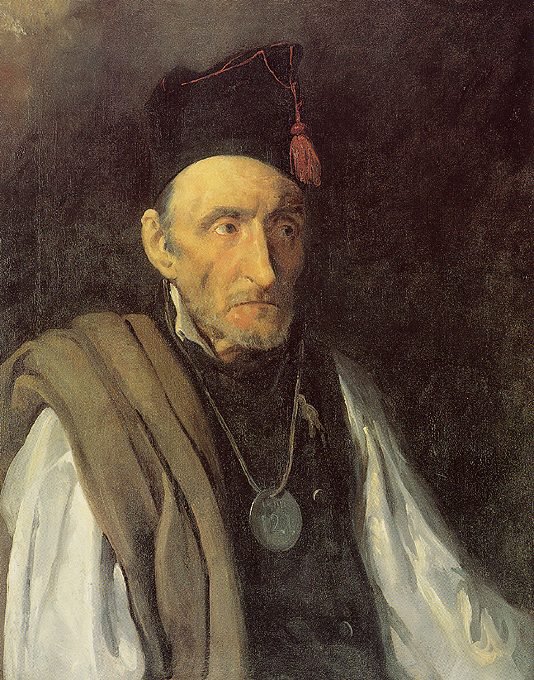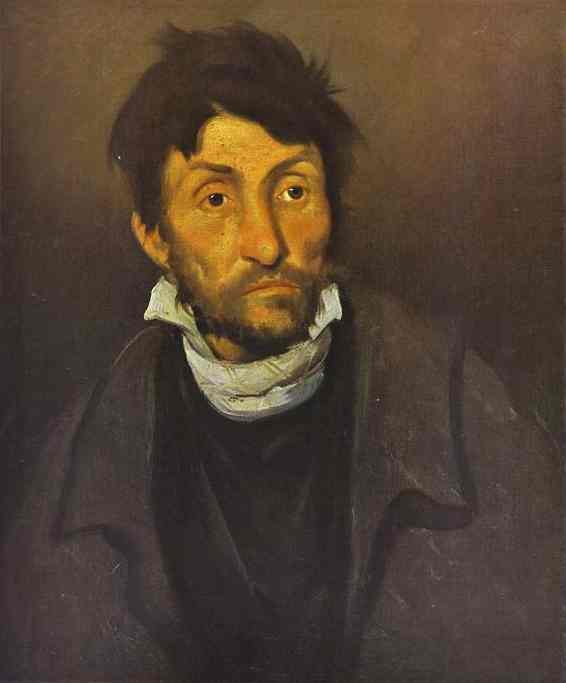
I have often mentioned in previous blogs that the subject for a blog frequently comes from something I have stumbled upon whilst researching another blog. Today’s blog is all about the Dutch painter Ary Scheffer who had a connection with the artist I talked about in the last two blogs, Théodore Géricault, but more of that connection later as I first want to look at the life of the Dutchman who was a leading Romantic painter.
Ary Scheffer came from an artistic background. His father was Johann- Bernhard Scheffer a portraitist who originally hailed from Hamburg but from his early teenage years lived in the Netherlands. He had married Cornellia Lamme, another artist who concentrated on miniature portraits. Ary Scheffer’s maternal grandfather was Arie Lamme the Dutch landscape painter. The couple, who lived in Dordrecht, had three sons, Ary, the eldest, was born in February 1795, his brother Karel Arnold Scheffer who was born in 1796, went on to become a journalist and writer and their youngest, Hendrik, who also became an artist, was born in September 1798.

Ary Scheffer was given his first artistic tuition by his parents but when he was eleven years of age his parents enrolled him at the Stadstekenacademie in Amsterdam on a three year art course. During that time he put forward one of his paintings, Hanibal Searing to Avenge the Death of his Brother Hasdrubal, in the first Exhibition of Living Masters in Amsterdam in 1808.
The painting is now in the Dordrecht Museum along with a number of his other works which are hung in the Ary Scheffer Room. That same year, his father became the court painter of Louis Bonaparte, who ruled over the Kingdom of Holland, a position bestowed on him by his brother, Napoleon Bonaparte. Ary’s father only held the position for a year as in 1809 he died. Following the death of her husband, Cornelia Scheffer moved to Paris with her three sons where Ary and his brother Hendrik became pupils at the studio of the French painter, Pierre Guérin. Ary and Hendrik were in good company at the studio as two of their fellow pupils would become the figureheads of the French Romantic movement in art, Eugène Delacroix and Théodore Géricault.
Ary Scheffer later attended the École des Beaux-Arts in Paris and from 1812 for the next thirty five years exhibited works at the annual Salons. Along with Delacroix and Géricault, Ary Scheffer is recognised as one of the great painters of the Romantic school. Following the end of the Revolution and the fall of Napoleon Bonaparte the French bourgeoisie once again came to prominence and along with the State were the main patrons of the Arts. Scheffer’s work was very popular and at the end of each Salon his paintings would be snapped up by eager buyers.

In the 1822 Salon he exhibited his very sentimental painting Soldier’s Widow which was very popular and although the whereabouts of the painting is unknown there are a number of monochrome prints of the work.

Ary Scheffer was also an excellent portraitist and in 1823 he completed probably one of the best portraits. It was of General Lafayette, the French aristocrat and military officer. It was a full-length standing portrait that was the most popular image of Lafayette as an older man, who had once been a general in the American Revolution War (1775-83) against the British and a close friend of George Washington. Lafayette was a popular subject for prints in the first half of the 19th century. He was a hero to both the French and the Americans; he was the first foreign dignitary to address a joint session of the U.S. Congress and in 1824, on the occasion of Lafayette’s celebrated tour of the United States, Ary Scheffer presented his painting to the U.S. House of Representatives. It has hung to the left of the Speaker’s rostrum since the opening of the current House Chamber in 1858. Lafayette would later figure in the French Revolution in 1789 and in the July Revolution of 1830 which led to Louis-Philippe becoming ruler of the French nation. This painting, entitled Gilbert de Motier, Marquis de Lafayette, is now part of the collection of the US House of Representatives in Washington.
When Louis-Philippe came to power in 1830 it marked the zenith of Scheffer’s artistic career. Scheffer, before the July revolution, had been giving drawing lessons to Louis-Philippe’s children and a great friendship between artist and his pupils blossomed. Once Louis-Philippe came to power after the 1830 Revolution, Scheffer attained an influential position within the court. Louis-Philippe became the patron of the artist and the Orleans family bought many of Scheffer’s paintings. Scheffer received numerous lucrative commissions for the Musée Historique at Versailles, which Louis-Philippe founded in 1837 and which was situated in the wings of the Palace of Versailles. The gallery which is one hundred and twenty metres long houses and also includes extensive tables that illustrate the major military events of the history of France.

Ary Scheffer also completed a number of Royal portraits including one in 1831 of Princess Marie of Orléans the third child and second daughter of Louis-Philippe and his wife Maria Amalia of the Two Sicilies. She later became the wife of Duke Alexander of Württenberg. She was the most talented artist of all the Royal children and was constantly encouraged to pursue her love of art and sculpture by Ari Scheffer. Sadly she died of tuberculosis when she was just twenty-five years old.

Another member of the he French Royal Family who featured in one of Scheffer’s portraits was Marie-Amalia, the niece of Marie-Antoinette and the wife of Louis-Philippe. Louis-Philippe had reigned as the French monarch from 1830 when he came to power following the July Revolution and ruled for eighteen years but was deposed in the February 1848 Revolution which resulted in he and his wife, Marie-Amalia living a life in exile in England.

The couple lived at Claremont, a stately home owned by Leopold of the Belgians, but lent out to Queen Victoria. In 1850 Louis-Philippe died but his widow remained at Claremont for the rest of her life. Ary Scheffer visited Claremont in 1857 at which time he completed the portrait of the ex-Queen. In it we see a frail seventy-five year old lady in mourning.

What persuaded me to feature Ary Scheffer was when I was looking at the death of Théodore Géricault at the young age of thirty-two; I came across a painting entitled The Death of Géricault by today’s featured artist, Ary Scheffer. It is beautiful work of art which highlights the French Romanticism style, which was so popular at the time. Look at the man sitting on the chair who was presumably one of Géricault’s close friends. Look at the way Scheffer has depicted him. He grasps Géricault’s limp wrist with his right hand whilst he buries his head on his left hand which lies across the back of the chair which he is sitting on. It is almost a scene from an old silent Hollywood movie or part of an amateur dramatics production. The physician holds Géricault’s left hand which lies almost lifeless over his heart. Look at Géricault’s face. It is sunken. It is almost skull-like. In my last blog I featured Géricault’s last self-portrait which was a very disturbing depiction and somebody commented that it could not have been that bad but what we see in Scheffer’s painting is very close to that self-portrait. This was the end for the great artist.
















